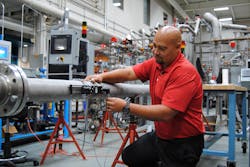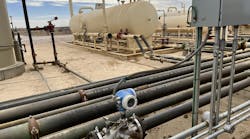Ultrasonic flowmeters have made tremendous strides since their development for industrial applications just a few short decades ago. The flowmeters are now widely employed in applications where minimal pressure drop, chemical compatibility and low maintenance are a must. The clamp-on transit-time variety of these meters are particularly versatile devices with many advantages.
This article describes how ongoing technology advancements have improved the accuracy and versatility of ultrasonic flowmeters, making them an effective solution for measuring volumetric flow in the most demanding environments.
Introduction
Practical flow measurement devices first emerged in the late 19th century for industrial and utility purposes. They subsequently evolved to meet the ever-increasing requirements for custom transfer and flow measurement of liquids and gases. However, industrial end users are still looking for solutions that will perform complicated flow measurement tasks with greater ease, accuracy and reliability, as well as deliver increased financial savings to their bottom line.
Although flow measurement technology is continually improving, the variety of meter types and styles has not stopped expanding, either. There are currently more than 60 different metering techniques in use across all industrial sectors.
While some flow measurement technologies have not changed much over the past decades, others have seen significant advancement. Some the biggest improvements have been in electronics and advanced diagnostics that make flowmeters much more useful in a host of measurement and control applications.
Through enhanced design and operating principles, modern flow metering equipment allows non-technical users to instantly understand what is occurring within the process, and this has had a major effect on both control and safety within work environments.
Progress of ultrasonic technology
Ultrasonic flowmeter technology has seen significant progress since its infancy in the early 1970s. Today, it is a dependable, accurate and cost-effective method of liquid and gas flow measurement across a broad scope of industries.
Ultrasonic flowmeters use sound waves at a frequency beyond the range of hearing. This ultrasound signal is sent into a stream of flowing liquid by using wetted (inline or insertion) transducers that make direct contact with the liquid or external (clamp-on) transducers that send the ultrasound through the pipe wall. Clamp-on ultrasonic flowmeters allow users to measure the volumetric flow rate of a fluid without having to penetrate the pipe, thus reducing installation and maintenance costs.
There are two main technical approaches within ultrasonic flowmeter technology:
- Doppler meters that send an ultrasonic signal across a pipe, measure the signal reflected off particles in the moving fluid and compute flow speed by measuring the Doppler shift.
- Transit-time meters that transmit two ultrasonic signals to a receiver on the other side of the pipe — one with the flow and one against the flow. The unit measures the difference in transit times between the two signals to calculate flow.
With an ultrasonic transit-time flowmeter, two ultrasonic transducers alternatively emit and receive signals protruding into the pipe. The signal going with the flow travels the distance faster than the one against the current. This time difference is measured and allows for the calculation of the flow velocity and the volume flow rate.
Ultrasonic clamp-on flowmeters have no moving parts and utilize secure silicon connections to process piping. This approach enables non-contact measurement of the most corrosive liquids while providing an overall lower cost of ownership.
Since the introduction of ultrasonic transit-time flowmeters in the 1990s, instrumentation manufacturers have continually improved their measurement and signal processing capabilities. Past innovations included the ability to measure gas and low flows. Flowmeter suppliers also brought out new multipath ultrasonic meters with enhanced features for custody transfer of natural gas and petroleum liquids.
According to Mordor Intelligence, a leading market research firm, the COVID-19 outbreak has had a positive impact on the growth of ultrasonic flowmeter technology. World Health Organization (WHO) guidelines dictate that the water supply must be kept safe, owing to the chances of transmission of the virus through sewage water. This factor is driving the adoption of biological wastewater treatment systems, which are well-suited for the use of ultrasonic flow measurement devices.
Latest meter design enhancements
Ultrasonic technology has found greater use in industrial flow measurement largely due to improvements to ultrasonic transducers, making them less expensive, more accurate, smaller and more widely available. Advanced integrated analog circuits have made it easier to perform real-time capture and processing of ultrasonic transducer waveforms to get accurate time-of-flight information. Since ultrasonic flowmeters do not have any moving parts, they have become a compelling choice for end users seeking to replace mechanical-type flowmeters.
The current breed of ultrasonic transit-time flowmeter offers key features such as increased data acquisition speed, as well as speed of sound measurement and digital communications. The meter’s increased resolution enables it to precisely track fluid movements in the lowest flow conditions. The latest transit-time devices sample the entire cross-sectional area of the flow profile to obtain a true average flow velocity and can calculate time measurement differential data to within nanoseconds.
In addition, developments in ultrasonic flowmeter technology are keeping pace with the digital world where the need for communication and connectivity increases by the day and end users are looking for smart metering solutions. In contrast to mechanical flowmeters, ultrasonic meters offer remote reading capabilities without the use of any add-on devices. This not only contributes to a significant decrease in data collection time but also saves time and money for more value-adding activities. Improvements in digital signal processing techniques also enable large amounts of data to be processed and stored in real time.
Manufacturers of ultrasonic flowmeters have taken advantage of ongoing technology improvements so that diagnostic parameters can now be used to perform a “health-check” of the meter when in operation. This can help the diagnosis of potential problems with the measured fluid or the measurement system.
The development of unique algorithms and techniques has resulted in ultrasonic flowmeters that work well in the most demanding low-flow conditions. Advancements in signal processing permit flow measurement across the entire Reynolds number range so that both viscous and non-viscous fluids can be metered accurately, while signal discrimination identifies anomalies in the flow.
Advanced ultrasonic flowmeter designs can even employ an integrated remote restriction valve, which enables users to actuate the valve remotely to either an open, restricted or partially restricted position.
Looking to future improvements
There’s no question that the technology behind ultrasonic flow measurement will see continued advances in the years ahead. The ultrasonic flowmeter market is benefiting from the drive for new energy sources, including the search for more oil and gas and expanding renewable energy development. The market is also continuing its shift from traditional flowmeters to “new technology” like ultrasonic meters at an increasing rate. Growing concerns with accuracy and reliability in measurement could accelerate this trend.
It is possible that tomorrow’s ultrasonic transit-time flowmeters will have a much faster sampling capability, providing dramatic improvements in their measurement resolution. This increased resolution would allow for the design of advanced transit-time meters that can precisely track fluid movements down to a true zero flow condition in the most challenging service environments.
Going forward, ultrasonic transit-time instruments will have the horsepower and accuracy to fit demanding flow applications that historically would have required more expensive flow measurement methods.
Conclusion
For many industrial applications, ultrasonic flow measurement technology represents the next generation of smart metering. While accuracy, reliability and long service life are the underpinning characteristics of this technology, there are many more value-added benefits than what meets the eye.
Ultrasonic flowmeters perform with high levels of precision and repeatability, require almost no maintenance and are versatile enough for use with a variety of conductive and non-conductive fluids. Most importantly, they offer the flexibility for installation in virtually any location at any time. Future innovations are expected to simplify complexities, reduce setup times and make clamp-on ultrasonic devices a wise investment for a wider range of end users.





